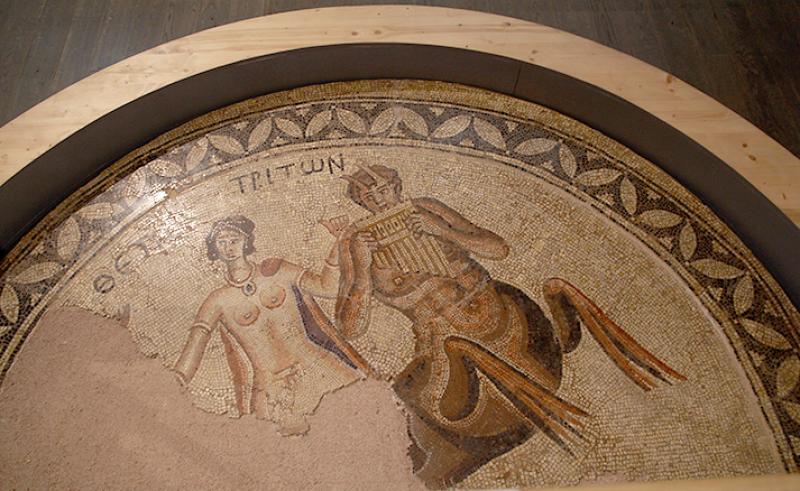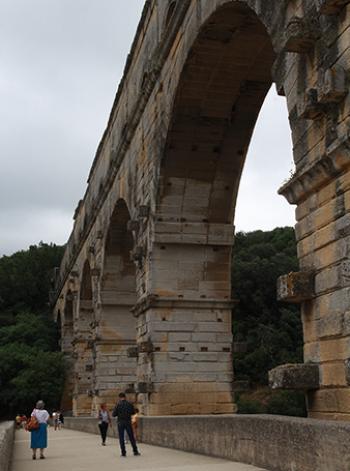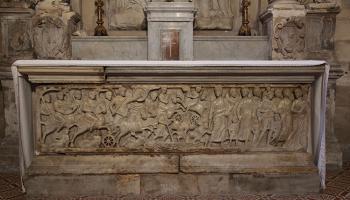Southwest France in July 2021
This item appears on page 13 of the January 2022 issue.
By late spring 2021, it looked like things were starting to return to normal. After checking on the rapidly evolving European Union (EU) travel regulations regarding COVID and talking to friends who live in Europe, my wife, Olimpia Velez, and I took a chance and booked flights to France for July 4-15, 2021.
Our itinerary had us flying from Boston through Munich, Germany, into Nice, France, where we picked up a rental car. After visiting sites from Arles to Toulouse, we flew home through Frankfurt.
As usual, I started with a list of about twice as many things to see than we could fit into a 10-day itinerary, but we narrowed it down to the primary Roman sites in the Languedoc region, along with museums and other historical sites.
Because tourism, particularly from North America, was still down, we were able to book several highly rated small hotels and B&Bs. Our style is to stay at one location for several nights and drive to nearby towns or attractions.
With tickets in hand by the end of April, the challenge was monitoring the rapidly changing COVID requirements. Each week, it seemed there was an update. We checked the websites for Lufthansa, the US Department of State and the French Embassy plus whatever popped up from authoritative sources in online searches. Finally, three weeks before our departure, the requirements stabilized, at least for our trip.
We didn’t need “within 72 hours” COVID tests for entry into Germany or France, but we did need to be fully vaccinated. Airline agents were the primary enforcers of COVID regulations, with border agents checking our vaccination cards on arrival in Munich to verify our status. Coming home, the US required a “within 72 hours” [now 24 hours — Ed.] COVID test along with our vaccine cards. And, of course, there were forms to fill out and present at check-in.
At the Avis counter in the Nice airport, we picked up our Dacia Sandero Stepway, a small, very nice SUV with updated safety features that included a back-up camera and navigation system. Including basic coverage and CDW, the 9-day rental cost $968.
The one surprise at the rental counter was we were given no paperwork. The reservation agent promised that we’d get an email with the contract, but this never arrived. This made me nervous. What if we were to have an accident?
We spent the first three nights of our trip in Uzès at La Taverne de Sophie (4 rue Xavier Sigalon, 30700 Uzès; phone +33 4 66 01 75 18, www.lataverne-uzes.fr [in French only]), a very nice B&B that has been in business for 40 years. We paid €90 (near $102) per night — €70 for the room and €10 each for breakfast.
The maps implied we could drive to the hotel. However, this wasn’t quite the case. After circling around the blocked street, we figured the best thing to do was quickly park and unload, then take the car to the parking garage around the corner. Parking was included in the hotel rate.
Uzès is a charming small town with a central square that has many restaurants. Wednesday mornings, there’s a market in the square.
In the area, we visited the Pont du Gard aqueduct, Arles and Nîmes. The Tour de France was going on, and we drove along several tour routes the day before it started, seeing lots of campers alongside the road from Uzès to Nîmes.
Nîmes has a new (2018) Roman museum, Musée de la Romanité, which was a highlight, as well as Maison Carrée, a Roman temple. In museums, masks were required and the rule was enforced. Masks were expected in stores too and in restaurants except when eating.
Our next base was Béziers, where we stayed three nights in a converted mill, La Chamberte B&B (10 rue de la Source, 34420 Villeneuve-lès-Béziers; phone +33 4 67 39 84 83, www.lachamberte.com [in French only]). We paid €99 for the night, which included breakfast.
This place proved to be a bit problematic, since there was a narrow staircase to our room that Olimpia had some difficulty navigating. Plus the room itself had two steps to navigate (including in the middle of the night) from the bed to the bathroom. We didn’t trip, but we would urge caution for anyone with mobility problems.
Villeneuve-lès-Béziers’ “new town,” which dates to the 1600s, had several restaurants within walking distance, and seafood was prominently featured.
Aside from the main city of Béziers, our stops in this area included Montpellier and Narbonne. Narbonne has a spectacular new (2020) Roman museum called Narbo Via, just a short walk from the city center. The first thing you see after buying your ticket is a huge wall full of Roman architectural fragments, grave markers and inscriptions. The rest of the museum is equally impressive.
We also visited the Abbaye de Fontfroide outside of Narbonne.
No trip to southwest France would be complete without a stop at Carcassonne, where we went next. We stayed at a small hotel in the “newer town,” Hôtel de la Bastide (81 rue de la Liberte, 11000 Carcassonne; phone +33 4 68 71 96 89, hoteldelabastide@wanadoo.fr), where we paid €97.40, including breakfast, for each of two nights.
In retrospect, we probably should have gone for a place inside the walled city. This was the only time we saw any real crowds, mostly French and Spanish tourists. I’d hate to think how bad things might be during a normal year!
From Carcassonne, we took a day trip to Albi — unplanned but worth the journey. The highlight was the Musée Toulouse-Lautrec.
Our final two nights were spent in Toulouse, with the second day being Bastille Day. Museums were still open during the day. At night, we heard fireworks but stayed in our hotel and packed for the trip home the next day.
We were in Hôtel Albert 1er Toulouse (8 rue Rivals, 31000 Toulouse; phone +33 6 44 64 40 51, hotel-albert1.com/en), where the desk clerk was particularly helpful working through some internet and printing problems we had. We paid €113 per night, breakfast included.
We reserved a morning slot at the Toulouse airport’s COVID test location. We discovered this facility through Lufthansa’s website (www.lufthansa.com/us/en/entry-requirements), where we selected our destination, then made our reservation on the Toulouse airport’s website (aeroport.aerohealth.ai/toulouse-blagnac/en).
This turned out to be a good idea, since there was a long line at the test center, with some people who hadn’t planned ahead trying to barge in. But our reservation was honored, and we got our results in 15 minutes.
I made the mistake with the US COVID entry forms of not printing all the pages of the form, taking only the page where we had entered data. This caused some problems at check-in, but they let us on the aircraft on the condition that we would print out the missing pages at the Lufthansa lounge in Frankfurt, where we’d be connecting to our flight home to Boston.
Another strange wrinkle was that we were given no paperwork when we returned the rental car. I did walk around and carefully video the entire car, in case there was a later claim of damage.
The final wrinkle happened after we got home. It took several weeks for my credit card to be charged for the Avis rental, and I was getting nervous. My big concern was any unexpected charges for mileage, fuel, damage, etc., but when the bill finally arrived, it was for the expected amount. A huge relief!
I’m currently taking a course in Roman architecture, so seeing some of the canonical examples, such as the amphitheaters in Arles and Nîmes, the Maison Carrée temple and the Pont du Gard aqueduct, made the class all the more informative.
Carcassonne lived up to its billing. Walking around the old city does take you back, if you can ignore the crowds.
But it’s the massive wall of carvings in Musée Narbo Via that sticks with me the most.
DAVID EMERY
Dover, NH



